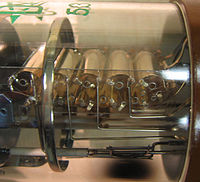
Photo from wikipedia
Abstract A new series of optically translucent borosilicate glasses activated with varying concentrations of Dy3+ ions were fabricated by employing melt quenching method. Spectral investigations were conducted by recording the… Click to show full abstract
Abstract A new series of optically translucent borosilicate glasses activated with varying concentrations of Dy3+ ions were fabricated by employing melt quenching method. Spectral investigations were conducted by recording the absorption, photoluminescent (PL) excitation and PL emission for Dy3+ activated borosilicate glasses. The absorption spectral information was exposed to Judd-Ofelt (J-O) analysis to calculate various radiative properties such as transition probability, total transition probability, branching ratios and radiative lifetimes of the as synthesized glasses. The excitation spectrum recorded under 483 nm emission wavelength possess a sharp peak at 348 nm in 0.1 mol% of Dy3+ ions doped borosilicate glass. Emission spectra recorded for all the Dy3+ ions activated borosilicate glasses under 348 nm intense excitation wavelength exhibit two potential peaks in visible region at 483 nm (4F9/2 → 6H15/2) and 575 nm (4F9/2 → 6H13/2). The emission centered at 483 nm is most prominent. Radiative properties measured from the absorption spectral feature were correlated with emission spectral information to estimate emission cross-section, gain bandwidth and optical gain parameters to understand the utility of the as synthesized glasses as photonic devices. The CIE coordinates measured for all the titled glasses are in good proximity with the white light coordinates of CIE 1931 diagram.
Journal Title: Optical Materials
Year Published: 2021
Link to full text (if available)
Share on Social Media: Sign Up to like & get
recommendations!